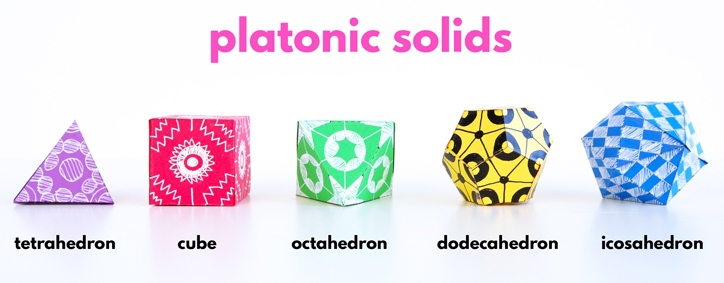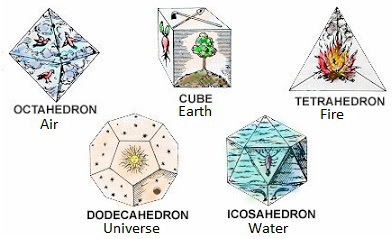Platonic Solids
Platonic solid is a regular convex polyhedron in which the faces are congruent regular polygons with the same number of faces meeting at each vertex.

Euclid proved that there are exactly five such solids in the last proposition of the Elements.





The Platonic solids were named after Plato, ancient Greek philosopher and mathematician. Plato theorized that the classical elements of the world were made of these regular solids. The five Platonic Solids were thought to represent the five basic elements: earth, air, fire, water, and the universe.
• The cube is associated with the earth, and reconnecting energy to nature.
• The octahedron is associated with air, and cultivating acceptance and compassion.
• The tetrahedron is associated with fire, and perpetuates balance and stability.
• The icosahedron is associated with water, and enhances creative though and expression.
• The dodecahedron is associated with the universe, and represents mystery and meditation.
Plato stated that the dodecahedron was "used for arranging the constellations on the whole heaven." The dodecahedron can be seen as representing the universe with the twelve zodiac signs corresponding to the twelve faces of the dodecahedron.

These regular solids occur in areas such as chemistry, crystallography, mineralogy, oceanography, medical virology, cytology (the study of cells), geology, meteorology, astrology, electronics, and architecture, to name only a few. The Platonic solids can be described as forming the basis of all structure.
Adana Bilim ve Sanat Merkezi
OŠ "Dr Dragiša Mišović", Čačak, Serbia
SPMąkoszyce and Jean Monnet High School
High School "Andrei Straistă" Republic of Moldova
SOU "BOGDANCI"
Gaudeamus High School - R.Moldova
Zigur Lelo School